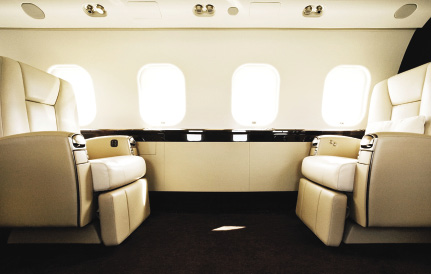- Home
- Media Kit
- Current Issue
- Past Issues
- Ad Specs-Submission
- Ad Print Settings
- Reprints (PDF)
- Photo Specifications (PDF)
- Contact Us

![]()
ONLINE

Selling Lifestyle
Editors’ Note
Using his wealth of experience in the financial services industry, Thomas Flohr transformed his passion for private aviation into VistaJet. He brought his business acumen and experience as President of a Fortune 500 company to this business.
Company Brief
In VistaJet (www.vistajet.com) Thomas Flohr designed a revolutionary private aviation business model focused entirely around clients. The firm invested in the largest privately owned fleet of aircraft outside the Americas and took their first flight in 2004. They are now the world’s fastest growing private aviation company with a fleet of Bombardier aircraft based across Europe, the Middle East, Asia, and West Africa, and their multilingual staff are based in offices across the globe.

A VistaJet private jet
What was your vision for VistaJet and how did it develop?
I used to work for an American company and we had a corporate jet so I was used to the efficiency it gave me. I went out on my own at the end of the ’90s and I missed that business tool. I tried every option in the market and there was no product giving me what I needed.
So in 2003, I bought my own plane. The original build of the plane was aluminum so I wanted to bring back that original silver color and then put a red stripe on it. It had Italian leather and wood inside, which gives it a European feel.
I placed that plane with a small local operator in 2004 and within two months, it was being chartered out and everyone loved it.
I immediately bought a second bigger one since the first one was paying for itself. Within three months of its arrival, it was flying 100 hours a month. That’s when I started to study this market and found that it was monopolized by one company. The rest was fragmented with hundreds of small operators operating owner aircraft, all subject to owner availability. So I developed the concept of not-subject-to-owner-availability.
Also, I didn’t want to abide by the home base concept, which results from an owner making his aircraft available. My planes might not see home base for three months because they can pick up new clients wherever they land.

Global 6000 interior
Finally, the concept of a fraction of an aircraft outside the U.S. is a culturally complicated and difficult product. We don’t have accelerated tax depreciation; Western Europe doesn’t recognize a fraction as an asset. As my Russian, Saudi, or Chinese friends say, either you own it or I own it.
The reason to own is either to have a tax advantage or because you believe the asset will increase in value. From 2005 through 2007, asset values of airplanes went up. The environment is different today where people don’t want to put their cash towards a business tool. But a plane is a fantastic asset. Even in the downturn, the planes never dipped below 65 to 70 percent of their original list price. So if you buy in volume and get a great discount, the need for appreciation is limited. There might well be an asset upside. If you buy at 80 and you depreciate over five years by four percent a year, you’re down to 60, but you could probably sell at 65 or 70. So asset protection is important to me.
I bought three more airplanes in 2005. I then bought out the operator to control quality and other operational issues. That was the start of VistaJet in the first quarter of 2006.
From there, it has been a matter of execution. In just three years, we doubled the number of passengers we flew and more than doubled the revenue and fleet size. It proved to be a resilient business model, focusing specifically on the high-end, long-range travel market. We have smaller airplanes, but the real market is in intercontinental flying.
Over the past five years, it’s been a mirror of the development of the BRINC countries – I add Nigeria in that mix. Ten or 15 years ago, all the trades in the world involved Western companies. Today, however, someone in Nigeria may be doing business directly with someone in Siberia, for instance. But the travel infrastructure between those areas is limited.
Is this a high-end niche market or is it broader than that?
The market is huge. We’re growing currently at a pace of 25 percent and that is before having entered the main market, which is China.
We had double effect after the recent recession. Companies that would previously have purchased a second or third aircraft are shying away from that. We also have people migrating from fractional; they feel uncomfortable with the asset investment into a fractional. Our target market is people who fly between 50 and 400 hours a year. The industry accepts that at 400 hours and below, it’s inefficient to buy airplanes.
We offer 24/7 availability and always provide the right aircraft for the right mission and that brings the overall cost per hour down because you’re not using a big asset for a short flight.
Ten years ago, 80 percent of all private jets were sold in North America; today, it’s 70 percent international. Europe has 2,400 private jets, North America has 10,000, China has 115, and Russia has 600. So there are obvious growth opportunities.
Is there a focus on the U.S. market?
No. We have a great partnership with FlexJet so if you’re an American flying with FlexJet and you fly in Europe, you book through FlexJet and are transported on VistaJet in Europe. For the client, it’s completely seamless.
Also, in the U.S., you don’t have the monopoly situation like in Europe; you have flight options.
Are you still competing with fractional companies?
In Europe, there is only NetJets. They have a huge customer base and are a good company. However, we don’t compete on price – with VistaJet you get better value for your money than with a fractional business model.
In our business model, most clients fly 100 hours or more, so I’m only taking six clients per aircraft. If you go down to a 25-hour card, then you need 32 clients and that clogs up your system. The guaranteed availability is a function of how many clients you have over how many flights you have in which geographical areas. We map that carefully.
Did you always know this business model would work?
Our customer loyalty and the fact that we were able to grow revenue even in 2009 has given me confidence. VistaJet has doubled in size since the beginning of the financial crises in September 2008.
What are your key priorities for moving forward?
I want to expand geographically because I see an unlimited requirement for our product. But I also will look at extensions because people buy the lifestyle of VistaJet.•